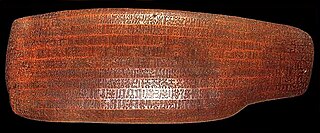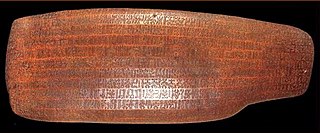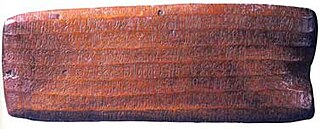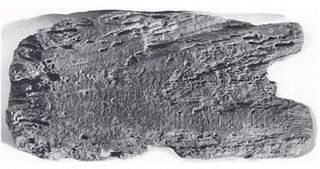
Text L of the rongorongo corpus, also known as (London) reimiro 2, is the smaller of two inscribed reimiro in London and one of two dozen surviving rongorongo texts.

Text L of the rongorongo corpus, also known as (London) reimiro 2, is the smaller of two inscribed reimiro in London and one of two dozen surviving rongorongo texts.
L is the standard designation, from Barthel (1958). Fischer (1997) refers to it as RR21.
British Museum, London. Catalog # AOA 9295.
A prototypical two-headed Rapanui reimiro, or ceremonial crescent-shaped gorget/epaulet, in excellent condition, 41.2 × 10.5 cm, made of Pacific rosewood (Orliac 2005). The two holes top center were used to hang it from clothing.
A line of glyphs has been cut along the length of the bottom edge on the front.
Fischer reports from her notes that Katherine Routledge showed a photo of this object to two Rapanui elders in July 1914. They said it was a woman's rei miro, worn five to a side.
Reimiro 2 was sold by Reverend William Sparrow Simpson, a collector who had never been to Easter Island, to the trustees of Christy Collection in January 1875. The trustees transferred it along with the rest of the Christy ethnological collection to the British Museum in 1883.
It is not known where Simpson acquired the object, but its history may be similar to that of rei miro 1.
Inscribed reimiro were evidently rare: An elder told Routledge that he had never seen a reimiro with glyphs.
Despite its poor provenance, there are no doubts as to its authenticity.
There is one line of about 50 glyphs, ending in half a dozen komari (vulvas). Fischer makes the enigmatic comment "Any evidence in natural light of seemingly 'effaced' glyphs (palimpsests) disappears in artificial light."

Rongorongo is a system of glyphs discovered in the 19th century on Easter Island. It is not yet known whether rongorongo represents true writing or proto-writing. Numerous attempts at decipherment have been made, but none have been successful so far. Although some calendrical and what might prove to be genealogical information has been identified, none of these glyphs can actually be read. If the system is writing and proves to be an independent invention, it would be one of very few independent inventions of writing in human history.

Rongorongo is a system of glyphs discovered in the 19th century on Easter Island that appears to be writing or proto-writing. Text B of the rongorongo corpus, also known as Aruku Kurenga, is one of two dozen surviving rongorongo texts.
Text C of the rongorongo corpus, also known as Mamari, is one of two dozen surviving rongorongo texts. It contains the Rapa Nui calendar.

Rongorongo is a system of glyphs discovered in the 19th century on Easter Island that appears to be writing or proto-writing. Text E of the rongorongo corpus, also known as Keiti, is one of two dozen known rongorongo texts, though it survives only in photographs and rubbings.

Text G of the rongorongo corpus, the smaller of two tablets located in Santiago and therefore also known as the Small Santiago tablet, is one of two dozen surviving rongorongo texts. It may include a short genealogy.

Text H of the rongorongo corpus, the larger of two tablets located in Santiago and therefore also known as the Great or Large Santiago tablet, is one of two dozen surviving rongorongo texts, and one of three recording the so-called "Grand Tradition".

Text I of the rongorongo corpus, also known as the Santiago Staff, is the longest of the two dozen surviving rongorongo texts. Statistical analysis suggests that its contents are distinct from those of the other texts.
Text N of the rongorongo corpus, the smaller of two tablets in Vienna and therefore also known as the Small Vienna tablet, is one of two dozen surviving rongorongo texts. It repeats much of the verso of tablet E.
Text Q of the rongorongo corpus, the smaller of two tablets in St. Petersburg and therefore also known as the Small St Petersburg tablet, is one of two dozen surviving rongorongo texts, and one of three recording the so-called "Grand Tradition".
Text P of the rongorongo corpus, the larger of two tablets in St. Petersburg and therefore also known as the Great or Large St Petersburg tablet, is one of two dozen surviving rongorongo texts, and one of three recording the so-called "Grand Tradition".

Text R of the rongorongo corpus, the smaller of two tablets in Washington and therefore also known as the Small Washington tablet, is one of two dozen surviving rongorongo texts.

Text S of the rongorongo corpus, the larger of two tablets in Washington and therefore also known as the Great or Large Washington tablet, is one of two dozen surviving rongorongo texts.
Text K of the rongorongo corpus, also known as the (Small) London tablet, is one of two dozen surviving rongorongo texts. It nearly duplicates the recto of tablet G.
Text T of the rongorongo corpus, also known as Honolulu tablet 1 or Honolulu 3629, is the only fluted tablet in the Honolulu collection and one of two dozen surviving rongorongo texts.
Text U of the rongorongo corpus, carved on a beam, also known as Honolulu tablet 2 or Honolulu 3628, is one of two dozen surviving rongorongo texts.
Text V of the rongorongo corpus, the Honolulu oar, also known as Honolulu tablet 3 or Honolulu 3622, may be one of two dozen surviving rongorongo texts. Its authenticity has been questioned.

Text J of the rongorongo corpus, also known as (London) reimiro 1, is the larger of two inscribed reimiro in London and one of two dozen surviving rongorongo texts.

Text M of the rongorongo corpus, the larger of two tablets in Vienna and therefore also known as the Large or Great Vienna tablet, is one of two dozen surviving rongorongo texts.

Text X of the rongorongo corpus, known as the (New York) Birdman, is one of two dozen surviving rongorongo texts.

There have been numerous attempts to decipher the rongorongo script of Easter Island since its discovery in the late nineteenth century. As with most undeciphered scripts, many of the proposals have been fanciful. Apart from a portion of one tablet which has been shown to deal with a lunar calendar, none of the texts are understood, and even the calendar cannot actually be read. The evidence is weak that rongorongo directly represents the Rapa Nui language – that is, that it is a true writing system – and oral accounts report that experts in one category of tablet were unable to read other tablets, suggesting either that rongorongo is not a unified system, or that it is proto-writing that requires the reader to already know the text. Assuming that rongorongo is writing, there are three serious obstacles to decipherment: the small number of remaining texts, comprising only 15,000 legible glyphs; the lack of context in which to interpret the texts, such as illustrations or parallel texts which can be read; and the fact that the modern Rapa Nui language is heavily mixed with Tahitian and is unlikely to closely reflect the language of the tablets—especially if they record a specialized register such as incantations—while the few remaining examples of the old language are heavily restricted in genre and may not correspond well to the tablets either.